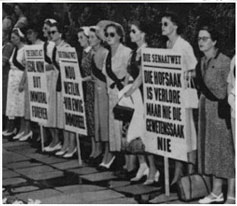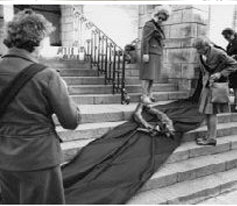History
|
Black Sash:
Mary Grice and her colleagues as an offshoot of the Durban Black Sash organization started Hillcrest Advice Bureau and Bursary Fund in 1972.
 The Black Sash had been born out of outrage over apartheid l The Black Sash had been born out of outrage over apartheid l aws, when six middle-class white women met for tea on 19 May 1955. They mobilized the support of thousands of others to march in protest against laws aimed at removing so-called ‘coloured’ people from the voters roll. Calling themselves the ‘Women’s Defence of the Constitution League’, they famously draped a black sash over a symbolic replica of the Constitution when the Senate Bill and the Separate Representation of Voters Bill were eventually passed. Despite their failed challenge, the women of the League refused to pack away their black sashes, which they had worn in mourning over the death of the Constitution. aws, when six middle-class white women met for tea on 19 May 1955. They mobilized the support of thousands of others to march in protest against laws aimed at removing so-called ‘coloured’ people from the voters roll. Calling themselves the ‘Women’s Defence of the Constitution League’, they famously draped a black sash over a symbolic replica of the Constitution when the Senate Bill and the Separate Representation of Voters Bill were eventually passed. Despite their failed challenge, the women of the League refused to pack away their black sashes, which they had worn in mourning over the death of the Constitution.
Instead, they formally took on the name of the Black Sash and embarked on new campaigns against the erosion of civil liberties, racial segregation and the damage inflicted by the policy of migrant labour. With a black sash draped from their shoulders, the members became iconic for their dignified and elegant style of protest. In Nelson Mandela’s first speech when he was released, he referred to the Black Sash as ‘The conscience of white South Africa’ during the dark days of apartheid. Soon afterwards, the first Black Sash advice office was opened in Athlone in Cape Town, offering free paralegal advice and support. Over the next five years, advice offices were opened in five other centres, staffed mainly by volunteers and supported by men and women from the townships who acted as interpreters. The advice offices acted as a free resource for those who sought out paralegal services for issues like housing, unemployment, pensions, influx control, detention without trial and so on.
Hillcrest Advice Bureau And Bursary Fund
The Advice Bureau was opened as an unofficial offshoot of the Durban Black Sash Advice office to make the advice services closer to people in the rural area of the Valley of 1000 Hills. It was obvious to the volunteers that the children of families seeking advice were not accessing their education due to the excruciating poverty and lack of money for food, transport, school fees and school uniforms. Mary Grice and her friends firmly believed that the only sustainable way out of poverty was through education and they started a feeding scheme, feeding up to 1000 children a week and paying school fees for the children of clients of the Advice Bureau. In those days no education was free. Hence the school Bursary Fund began. In due course the first children supported by the Bursary Fund matriculated: HABandBF supported the brightest of them in attending tertiary education and the Tertiary Fund was born. Nowadays the Tertiary Fund is our main activity as the hurdles to accessing a primary and high school education have been significantly reduced, although the issue now is unfortunately the quality of facilities and education provided. In order to address the problem of Matriculants not obtaining student funding through the National Student Financial Aid Scheme (NSFAS) or, indeed, having appropriate tertiary education places offered to them, the Central Applications Office Project (CAO Project) was started in 2017. The CAO project assists Grade 12 learners in identifying courses of tertiary study appropriate to their personalities and abilities and assists them in applying for places and financial support in good time.
The Holy Trinity Anglican church in Hillcrest donates support through generously providing us with a base and office facilities although we are a non-sectarian organization. We celebrated our 50th Year in June 2022. New and old faces have come and gone, but the same courageous spirit still lives on.
|
Enable GingerCannot connect to Ginger Check your internet connection
or reload the browserDisable in this text fieldRephraseRephrase current sentenceEdit in Ginger
Enable GingerCannot connect to Ginger Check your internet connection
or reload the browserDisable in this text fieldRephraseRephrase current sentenceEdit in Ginger